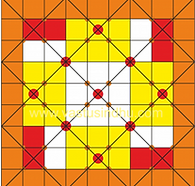”Indian sacred architecture of whatever date, style, or dedication goes back to something timelessly ancient and now outside India almost wholly lost, something which belongs to the past, and yet it goes forward too, though this the rationalistic mind will not easily admit, to something which will return upon us and is already beginning to return, something which belongs to the future.”
-Sri Aurobindo, The Renaissance in India
Vastu Consultant & Teacher

Vãstumandal: A Symbol of the Cosmos
Vastumandal
The Vastumandal denotes the Cosmic World and forms the basis of all Vastu planning. It represents the highest level of Design Philosophy from concept to theory to the actual process of construction. Vastumandal is always drawn square, for Square is a perfect shape, a fundamental form, and also the shape of the Earth element which contains within it the elements of Space, Air, Fire, and water, as also of speech, touch, shape, taste, and smell. It has poise, balance and makes a practical basis for designing a building.
The 7th chapter of Mayamatam lists the deities which occupy the Vãstumandal:
दैवतस्थानानि
ईशानश्चैव पर्जन्यो जयन्तश्च महेन्द्रकः ।
आदित्यः सत्यकश्चैव भृशश्चैवान्तरिक्षकः ॥३४॥
अग्निः पूषा च वितथो राक्षसश्च यमस्तथा ।
गन्धर्वो भृङ्गराजश्च मृषश्च पितृदेवताः ॥३५॥
दौवारिकश्च सुग्रीवः पुष्पदन्तो जलाधिपः ।
असुरः शोषरोगौ च वायुर्नागस्तथैव च ॥३६॥
मुख्यो भल्लाटकश्चैव सोमश्चैव मृगस्तथा ।
अदितिश्चोदितिश्चैव द्वात्रिंशद् बाह्यदेवताः ॥३७॥
आपश्चैवापवत्सश्चैवान्तः प्रागुत्तरे स्मृतौ ।
सविन्द्रश्चैव साविन्द्रश्चान्तः प्राग्दक्षिणे स्मृतौ ॥३८॥
इन्द्रश्चैवेन्द्रराजश्च दक्षिणापरतः स्थितौ ।
रुद्रो रुद्रजयश्चैव पश्चिमोत्तरतो दिशि ॥३९॥
ब्रह्मा मध्ये स्थितः शम्भुस्तन्मुखस्थाश्चतुः सुराः ।
आर्यो विवस्वान् मित्रश्च भूधरश्चैव कीर्तिताः ॥४०॥
चरकी च विदारी च पूतना पापराक्षसी ।
ईशानादि बहिः स्थाप्याश्चतुष्कोणे स्त्रियः स्मृताः ४१॥मयमतम् , सप्तमोऽध्यायः
The vertical, horizontal, and diagonal lines of the Vastumandal define various cosmic energies and their flow paths. Each side of the Vastumandal is divided into several different parts called pada. Mandals are drawn from 1×1 pada for designing ceremonial alters up to 32 x 32 pada for designing townships. The most common mandal, however, is of 9×9 pada which is generally accepted for all building designs. Each pada is governed by a deity whose encoded name carries the attribute of that pada.
Vithivinyasa

The central region of 9 squares is called Bramhavithi and has the highest concentration of energy. No construction should be done here. Surrounding it is Devavithi, the region of gods, and Manushyavithi, the region of humans. Construction is allowed in these two zones. The outermost area is called Pishachvithi, the region of darkness where again no construction is allowed.
Marma Pratishtha

The Vastumandal is crisscrossed by lines which are called nadi, rajju and sutra. These lines represent the Energy Meridians of a plot, and the points where they intersect are called Marma. These Marma are classified as Upamarma, Marma, Mahamarma, and Atimarma. The Mahamarma and Atimarma are very delicate and should not be disturbed, and therefore it is very important to identify their position and size before planning a building.
Ayadi Calculations
Ayadi calculations are a set of six intricate calculations that are made to check the energic suitability of the plot and its relationship with the owner.
Yoni: Direction of Energy Flow
Yoni calculation determines the direction of the flow of prana of the land. The direction of the flow of Energy of a plot depends upon the size of its perimeter. The flow of energy in cardinal directions sustains life and growth whereas its flow in the four corners of the Vastumandala is detrimental to growth and prosperity.
Directional Attributes
The attributes of different directions of the Vastumandal determine the placement of various building components on different parts of the plot. Broadly, East denotes Light, West denotes Darkness, North denotes Birth and South denotes Death. NE is the source of all energies, and SW is where they travel and disappear. Based upon these attributes, certain areas are preferred low and free of heavy construction while some are preferred raised. Here is a summary:

